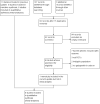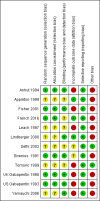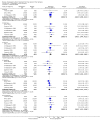Gabapentin add-on treatment for drug-resistant focal epilepsy
- PMID: 30357813
- PMCID: PMC6517293
- DOI: 10.1002/14651858.CD001415.pub3
Gabapentin add-on treatment for drug-resistant focal epilepsy
Update in
-
Gabapentin add-on treatment for drug-resistant focal epilepsy.Cochrane Database Syst Rev. 2021 Jan 12;1(1):CD001415. doi: 10.1002/14651858.CD001415.pub4. Cochrane Database Syst Rev. 2021. PMID: 33434292 Free PMC article.
Abstract
Background: This is an updated version of the Cochrane Review previously published in 2013.Most people with epilepsy have a good prognosis and their seizures are well controlled by a single antiepileptic drug, but up to 30% develop drug-resistant epilepsy, especially those with focal seizures. In this review, we summarised the evidence from randomised controlled trials (RCTs) of gabapentin, when used as an add-on treatment for drug-resistant focal epilepsy.
Objectives: To evaluate the efficacy and tolerability of gabapentin when used as an add-on treatment for people with drug-resistant focal epilepsy.
Search methods: For the latest update, we searched the Cochrane Register of Studies (CRS Web, 20 March 2018), which includes the Cochrane Epilepsy Group's Specialized Register and the Cochrane Central Register of Controlled Trials (CENTRAL), MEDLINE (Ovid, 1946 to 20 March 2018), ClinicalTrials.gov (20 March 2018) and the World Health Organization International Clinical Trials Registry Platform (ICTRP, 20 March 2018). We imposed no language restrictions.
Selection criteria: Randomised, placebo-controlled, double-blind, add-on trials of gabapentin in people with drug-resistant focal epilepsy. We also included trials using an active drug control group or comparing different doses of gabapentin.
Data collection and analysis: For this update, two review authors independently selected trials for inclusion and extracted the relevant data. We assessed the following outcomes: seizure frequency, seizure freedom, treatment withdrawal (any reason) and adverse effects. Primary analyses were intention-to-treat. We also undertook sensitivity best-case and worst-case analyses. We estimated summary risk ratios (RR) for each outcome and evaluated dose-response in regression models.
Main results: We included 12 trials representing 2607 randomised participants. We combined data from six trials in meta-analyses of 1206 randomised participants. The overall RR for reduction in seizure frequency of 50% or more compared to placebo was 1.89 (95% confidence interval (CI) 1.40 to 2.55; 6 trials, 1206 participants; moderate-quality evidence). Dose regression analysis (for trials in adults) showed increasing efficacy with increasing dose, with 25.3% (19.3 to 32.3) of people responding to gabapentin 1800 mg compared to 9.7% on placebo, a 15.5% increase in response rate (8.5 to 22.5). The RR for treatment withdrawal compared to placebo was 1.05 (95% CI 0.74 to 1.49; 6 trials, 1206 participants; moderate-quality evidence). Adverse effects were significantly associated with gabapentin compared to placebo. RRs were as follows: ataxia 2.01 (99% CI 0.98 to 4.11; 3 studies, 787 participants; low-quality evidence), dizziness 2.43 (99% CI 1.44 to 4.12; 6 studies, 1206 participants; moderate-quality evidence), fatigue 1.95 (99% CI 0.99 to 3.82; 5 studies, 1161 participants; low-quality evidence) and somnolence 1.93 (99% CI 1.22 to 3.06; 6 studies, 1206 participants; moderate-quality evidence). There were no significant differences for the adverse effects of headache (RR 0.79, 99% CI 0.46 to 1.35; 6 studies, 1206 participants; moderate-quality evidence) or nausea (RR 0.95, 99% CI 0.52 to 1.73; 4 trials, 1034 participants; moderate-quality evidence). Overall, the studies were rated at low to unclear risk of bias due to information on each risk of bias domain not being available. We judged the overall quality of evidence (using the GRADE approach) as low to moderate due to potential attrition bias resulting from missing outcome data and imprecise results with wide confidence intervals.
Authors' conclusions: Gabapentin has efficacy as an add-on treatment in people with drug-resistant focal epilepsy. However, the trials reviewed were of relatively short duration and provide no evidence for the long-term efficacy of gabapentin beyond a three-month period. The results cannot be extrapolated to monotherapy or to people with other epilepsy types.
Conflict of interest statement
SB: none known.
JW: none known.
MP: none known.
JLH: none known.
AGM: a consortium of pharmaceutical companies (GSK, EISAI, UCB Pharma) funded the National Audit of Seizure Management in Hospitals (NASH) through grants paid to the University of Liverpool. Professor Tony Marson is part funded by National Institute for Health Research Collaboration for Leadership in Applied Health Research and Care North West Coast (NIHR CLAHRC NWC).
Figures







Update of
-
Gabapentin add-on for drug-resistant partial epilepsy.Cochrane Database Syst Rev. 2013 Jul 25;(7):CD001415. doi: 10.1002/14651858.CD001415.pub2. Cochrane Database Syst Rev. 2013. Update in: Cochrane Database Syst Rev. 2018 Oct 24;10:CD001415. doi: 10.1002/14651858.CD001415.pub3. PMID: 23888424 Updated.
Similar articles
-
Lamotrigine add-on therapy for drug-resistant focal epilepsy.Cochrane Database Syst Rev. 2020 Mar 20;3(3):CD001909. doi: 10.1002/14651858.CD001909.pub3. Cochrane Database Syst Rev. 2020. Update in: Cochrane Database Syst Rev. 2023 Dec 11;12:CD001909. doi: 10.1002/14651858.CD001909.pub4. PMID: 32196639 Free PMC article. Updated.
-
Gabapentin add-on treatment for drug-resistant focal epilepsy.Cochrane Database Syst Rev. 2021 Jan 12;1(1):CD001415. doi: 10.1002/14651858.CD001415.pub4. Cochrane Database Syst Rev. 2021. PMID: 33434292 Free PMC article.
-
Gabapentin add-on for drug-resistant partial epilepsy.Cochrane Database Syst Rev. 2013 Jul 25;(7):CD001415. doi: 10.1002/14651858.CD001415.pub2. Cochrane Database Syst Rev. 2013. Update in: Cochrane Database Syst Rev. 2018 Oct 24;10:CD001415. doi: 10.1002/14651858.CD001415.pub3. PMID: 23888424 Updated.
-
Pregabalin add-on for drug-resistant focal epilepsy.Cochrane Database Syst Rev. 2019 Jul 9;7(7):CD005612. doi: 10.1002/14651858.CD005612.pub4. Cochrane Database Syst Rev. 2019. Update in: Cochrane Database Syst Rev. 2022 Mar 29;3:CD005612. doi: 10.1002/14651858.CD005612.pub5. PMID: 31287157 Free PMC article. Updated.
-
Zonisamide add-on therapy for focal epilepsy.Cochrane Database Syst Rev. 2018 Oct 18;10(10):CD001416. doi: 10.1002/14651858.CD001416.pub4. Cochrane Database Syst Rev. 2018. Update in: Cochrane Database Syst Rev. 2020 Jul 24;7:CD001416. doi: 10.1002/14651858.CD001416.pub5. PMID: 30335200 Free PMC article. Updated.
Cited by
-
The solute carrier transporters and the brain: Physiological and pharmacological implications.Asian J Pharm Sci. 2020 Mar;15(2):131-144. doi: 10.1016/j.ajps.2019.09.002. Epub 2019 Nov 13. Asian J Pharm Sci. 2020. PMID: 32373195 Free PMC article. Review.
-
Lamotrigine add-on therapy for drug-resistant focal epilepsy.Cochrane Database Syst Rev. 2020 Mar 20;3(3):CD001909. doi: 10.1002/14651858.CD001909.pub3. Cochrane Database Syst Rev. 2020. Update in: Cochrane Database Syst Rev. 2023 Dec 11;12:CD001909. doi: 10.1002/14651858.CD001909.pub4. PMID: 32196639 Free PMC article. Updated.
-
Gabapentin add-on treatment for drug-resistant focal epilepsy.Cochrane Database Syst Rev. 2021 Jan 12;1(1):CD001415. doi: 10.1002/14651858.CD001415.pub4. Cochrane Database Syst Rev. 2021. PMID: 33434292 Free PMC article.
-
Lamotrigine add-on therapy for drug-resistant focal epilepsy.Cochrane Database Syst Rev. 2023 Dec 11;12(12):CD001909. doi: 10.1002/14651858.CD001909.pub4. Cochrane Database Syst Rev. 2023. PMID: 38078494 Free PMC article.
References
References to studies included in this review
Anhut 1994 {published and unpublished data}
-
- Anhut H, Ashman P, Feuerstein TJ, Sauermann W, Saunders M, Schmidt B. Gabapentin (Neurontin) as add‐on therapy in patients with partial seizures: a double‐blind, placebo‐controlled study. Epilepsia 1994;35(4):795‐801. - PubMed
Appleton 1999 {published data only}
-
- Appleton R, Fichtner K, LaMoreaux L, Alexander J, Halsall G, Murray G, et al. and the Gabapentin Paediatric Study Group. Gabapentin as add‐on therapy in children with refractory partial seizures: a 12 week, multicentre, double blind placebo controlled study. Epilepsia 1999;40(8):1147‐54. - PubMed
Fisher 2001 {published data only}
-
- Fisher RS, Sachdeo RC, Pellock J, Penovich PE, Mahnus L, Bernstein P. Rapid Initiation of gabapentin: a randomised control trial. Neurology 2001;56:743‐8. - PubMed
French 2016 {published data only}
Leach 1997 {published data only}
Lindberger 2000 {published data only}
-
- Lindberger M, Alenius M, Frisen L, Johannessen SI, Larsson S, Malmgren K, et al. on behalf of the GREAT Study Investigators Group. Gabapentin versus vigabatrin as first add‐on for patients with partial seizures that failed to respond to monotherapy: a randomised, double‐blind, dose titration study. Epilepsia 2000;41(10):1289‐95. - PubMed
Sethi 2002 {published data only}
-
- Sethi A, Chandra D, Puir V, Mallika V. Gabapentin and lamotrigine in Indian patients of partial epilepsy refractory to carbamazepine. Neurology India 2002;50(3):359‐63. - PubMed
Sivenius 1991 {published and unpublished data}
-
- Sivenius J, Kalviainen R, Ylinen A, Riekkinen P. Double blind study of gabapentin in the treatment of partial seizures. Epilepsia 1991;32(4):539‐42. - PubMed
Tomovic 1999 {published data only}
-
- Tomovic M, Ilic T, Mihajlovic M, Jovicic A. Gabapentin as adjuvant therapy in the treatment of refractory partial epilepsy. Vojnosanit Pregl 1999;56(2):151‐6. - PubMed
UK Gabapentin 1990 {published and unpublished data}
-
- UK Gabapentin Study Group. Gabapentin in partial epilepsy. Lancet 1990;335(8698):1114‐7. - PubMed
US Gabapentin 1993 {published and unpublished data}
-
- US Gabapentin Study Group No 5. Gabapentin as add‐on therapy in refractory partial epilepsy: a double‐blind, placebo‐controlled, parallel‐group study. Neurology 1993;43(11):2292‐8. - PubMed
Yamauchi 2006 {published data only}
-
- Yamauchi T, Kaneko S, Vagi K, Sase S. Treatment of partial seizures with gabapentin: double‐blind, placebo‐controlled, parallel‐group study. Psychiatry and Clinical Neurosciences 2006;60(4):507‐15. - PubMed
References to studies excluded from this review
Arya 2013 {published data only}
Bodalia 2013 {published data only}
-
- Bodalia PN, Grosso AM, Sofat R, Macallister RJ, Smeeth L, Dhillon S. Comparative efficacy and tolerability of anti‐epileptic drugs for refractory focal epilepsy: systematic review and network meta‐analysis reveals the need for long term comparator trials. British Journal of Clinical Pharmacology 2013;76(5):649‐67. - PMC - PubMed
Crawford 1987 {published data only}
Jacoby 2015 {published data only}
-
- Jacoby A, Sudell M, Tudur Smith C, Crossley J, Marson AG, Baker GA. Quality‐of‐life outcomes of initiating treatment with standard and newer antiepileptic drugs in adults with new‐onset epilepsy: findings from the SANAD trial. Epilepsia 2015;56(3):460‐72. - PubMed
Korean Gabapentin Study Group 2000 {published data only}
-
- Korean Gabapentin Study Group. Comparative clinical trial of gabapentin and sodium valproate as add‐on therapy in refractory partial epilepsies: open randomized multicenter trial. Journal of Korean Epilepsy Society 2000;4(1):19‐26.
Nonoda 2014 {published data only}
-
- Nonoda Y, Iwasaki T, Ishii M. The efficacy of gabapentin in children of partial seizures and the blood levels. Brain & Development 2014;36(3):194‐202. - PubMed
Ohtsuka 2014 {published data only}
-
- Ohtsuka Y. New antiepileptic drugs: characteristics and clinical applications. Japanese Journal of Clinical Medicine 2014;72(5):931‐8. - PubMed
Semah 2014 {published data only}
-
- Semah F, Thomas P, Coulbaut S, Derambure P. Early add‐on treatment vs alternative monotherapy in patients with partial epilepsy. Epileptic Disorders 2014;16(2):165‐74. - PubMed
References to studies awaiting assessment
Kwan 2000 {published data only}
-
- Kwan SY, Yiu CH, Su MS. A double blind study of gabapentin in partial seizures. Epilepsia 2000;41(Suppl):69.
Shapiro 2000 {published data only}
-
- Shapiro DY, Nordli D, Glauser TA, Knapp LE, Greiner M, Purcell TJ, et al. Gabapentin as add‐on therapy for refractory partial seizures in children 1‐36 months of age: a novel, short‐term, placebo‐controlled trial. Epilepsia 2000;41(Suppl 7):106.
Additional references
Barker‐Haliski 2014
-
- Barker‐Haliski M, Sills GJ, White HS. What are the arguments for and against rational therapy for epilepsy?. Advances in Experimental Medicine & Biology 2014;813:295‐308. - PubMed
British National Formulary
-
- British National Formulary. www.bnf.org/.
Cockerell 1995
-
- Cockerell OC, Johnson AL, Sander JW, Hart YM, Shorvon SD. Remission of epilepsy: results from the national general practice study of epilepsy. Lancet 1995;346:140‐4. - PubMed
GRADEpro GDT 2015 [Computer program]
-
- GRADE Working Group, McMaster University. GRADEpro GDT. Hamilton (ON): GRADE Working Group, McMaster University, 2015.
Hauser 1993
-
- Hauser WA, Annegers JF, Kurland LT. Incidence of epilepsy and unprovoked seizures in Rochester, Minnesota: 1935‐1984. Epilepsia 1993;34:453‐68. - PubMed
Higgins 2011
-
- Higgins JP, Green S, editor(s). Cochrane Handbook for Systematic Reviews of Interventions Version 5.1.0 (updated March 2011). The Cochrane Collaboration, 2011. Available from handbook.cochrane.org.
Kirkham 2010
-
- Kirkham J, Dwan K, Altman D, Gamble C, Dodd S, Smyth R, et al. The impact of outcome reporting bias in randomised controlled trials on a cohort of systematic reviews. BMJ 2010;340:c365. - PubMed
Lefebvre 2011
-
- Lefebvre C, Manheimer E, Glanville J. Chapter 6: Searching for studies. In: Higgins JPT, Green S, editor(s). Cochrane Handbook for Systematic Reviews of Interventions Version 5.1.0 (updated March 2011). The Cochrane Collaboration, 2011. Available from handbook.cochrane.org/.
Loscher 2002
-
- Loscher W. Current status and future directions in the pharmacotherapy of epilepsy. Trends in Pharmacological Sciences 2002;23(3):113‐8. - PubMed
McClean 1995
-
- McClean MJ. Gabapentin. Epilepsia 1995;36 Suppl(2):72‐86. - PubMed
McCullagh 1989
-
- McCullagh P, Nelder JA. Generalized Linear Models. 2nd Edition. London: Chapman and Hall, 1989.
Panebianco 2015
Reynolds 1981
-
- Reynolds EH, Shorvon SD, Galbraith AW. Phenytoin for epilepsy: a long term prospective study, assisted by serum level monitoring in previously untreated patients. Epilepsia 1981;22:475. - PubMed
Scheffer 2017
Schünemann 2013
-
- Schünemann H, Brożek J, Guyatt G, Oxman A, editor(s), Grade Working Group. GRADE handbook for grading quality of evidence and strength of recommendations. Available from www.guidelinedevelopment.org/handbook 2013.
References to other published versions of this review
Al‐Bachari 2013
Publication types
MeSH terms
Substances
Grants and funding
LinkOut - more resources
Full Text Sources

